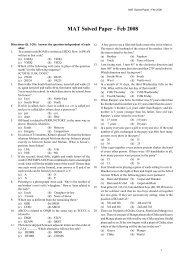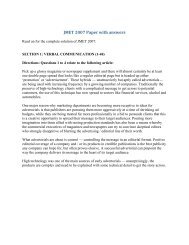PREVIOUS FMS QUESTION PAPER
PREVIOUS FMS QUESTION PAPER
PREVIOUS FMS QUESTION PAPER
Create successful ePaper yourself
Turn your PDF publications into a flip-book with our unique Google optimized e-Paper software.
(4) Rawls believes that there are conflicting<br />
concerns that may lead to an understanding of<br />
justice<br />
14. According to the passage,<br />
(1) There is no theory of how to ensure justice in<br />
an unbiased and impartial way<br />
(2) One cannot treat people with economic equity<br />
and distributional fairness<br />
(3) There is a general theory of economic equity<br />
and distributional fairness<br />
(4) None of the above<br />
15. Which of the following is a correct statement?<br />
(1) Rawls suggests the theory ‘justice as fairness’<br />
(2) The author of the passage suggests the theory<br />
‘justice as fairness’<br />
(3) Both Rawls and the author of the passage<br />
suggest the theory ‘justice as fairness’<br />
(4) None of the above<br />
Directions for Questions Nos. 16 to 26: Read the<br />
following passage - 2 and answer the questions given at<br />
the end of the passage. The answers should be based<br />
either on the author’s views or inferences drawn from<br />
the given passage.<br />
Passage – 2<br />
Diwali saw the last great burst of the autumnal<br />
exuberance unleashed a month earlier at Dusshera.<br />
Within a month of the last Diwali rocket vanishing into<br />
the Delhi skies, the city seemed to curl its tail between<br />
its legs and disappear into a state of semi-hibernation<br />
for the duration of the cold season. The brief but bitter<br />
Delhi winter came as suddenly as an undertaker: darkclad,<br />
soft-footed, unannounced and unwelcome. There<br />
is no snow in Delhi – the winters are too dry – but,<br />
white winds from the snow peaks still sweep down the<br />
slopes, freezing the plains of the Punjab and shattering<br />
the brittle buds, before raking through the streets of<br />
the capital and brushing the narrow Delhi alleyways<br />
clear of people. The Delhi–wallahs withdraw into<br />
themselves. They lift up their knees to their chins and<br />
pull their heavy Kashmiri blankets tightly around. Over<br />
their heads they wind thick woollen mufflers. If you<br />
look into the dark of the roadside restaurant-shacks<br />
PP-02 2A.5<br />
<strong>FMS</strong> Dec 2010<br />
you see only the whites of their eyes peering out into<br />
the cold.<br />
The sky is grey, the air is grey, and the dull, cold<br />
greyness seeps into the ground, the stones and the<br />
buildings. The only colours are the red and yellow silk<br />
flags flying over the new Muslim graves in Nizamuddin.<br />
The trees in the gardens stand shrouded in a thin wrap<br />
of mist. In Old Delhi, the goats fattening for slaughter<br />
huddle together under sackcloth coats; some are given<br />
old cardigans to wear, with their front legs fitted<br />
through the sleeves. Winter smoke winds slowly out of<br />
the chimneys; bonfires crackle outside the jhuggi<br />
clusters. As you look through the windowpanes you can<br />
see winter lying curled like a cobra across the land.<br />
Olivia now spent her mornings in the warmth of our<br />
flat; it was too cold and misty to paint until the sun had<br />
reached its zenith at midday. If she ventured out she<br />
would return early, before a sudden dusk brought to a<br />
close the brief winter afternoon. Brisk evenings were<br />
followed by cold nights. We muffled ourselves in our<br />
new shawls – we had not considered packing jerseys or<br />
overcoats when we set off to India – and sat warming<br />
ourselves, in front of the heaters. My reading was<br />
mostly historical. I had become fascinated with that<br />
period of Delhi’s history known as the Twilight. It was<br />
an epoch whose dark melancholy perfectly reflected<br />
the cold, misty scenes outside our own windows.<br />
The Twilight is bounded by two of the greatest<br />
disasters in Delhi’s history: the Persian massacres of<br />
1739 and the equally vicious hangings and killings<br />
which followed the British recapture of Delhi after the<br />
1857 Indian Mutiny. The first massacre took place in<br />
the wake of an unexpected invasion of India by the<br />
Persian ruler, Nadir Shah. At Karnal in the Punjab the<br />
newly-crowned Shah defeated the Mughal army and<br />
advanced rapidly on Delhi. He encamped at the<br />
Shalimar Gardens, five miles north of the city. Having<br />
been invited into Delhi by the nervous populace, Nadir<br />
Shah ordered the massacre after a group of Delhiwallahs<br />
attacked and killed 900 of his soldiers in a<br />
bazaar brawl. At the end of a single day’s slaughter 1,<br />
50,000 of the city’s citizens lay dead.<br />
Nadir Shah’s massacre exacerbated the decline of the<br />
Mughal Empire which had been steadily contracting<br />
since the death of Aurangzeb, the last Great Mogul, in
















